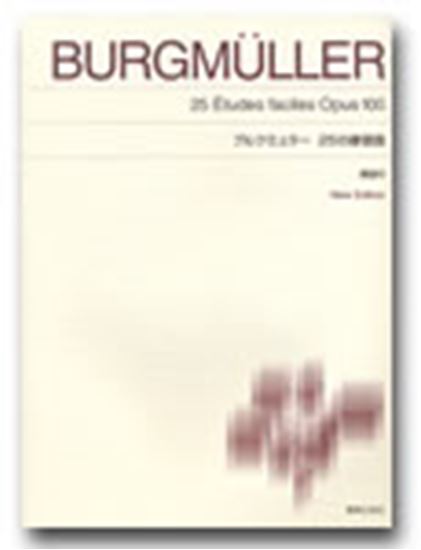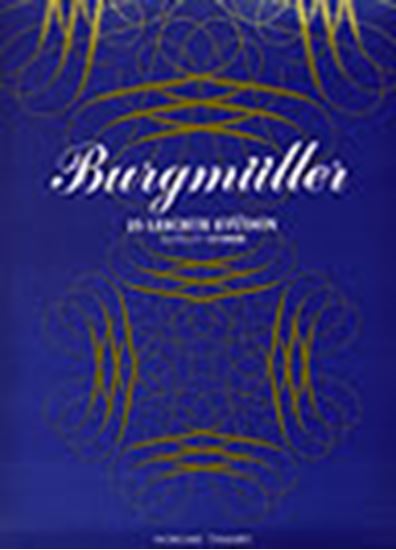Burgmüller, Johann Friedrich Franz : 25 Etudes faciles et progressives, conposées et doigtées expressément pour l'étendue des petites mains Innocence Op.100-5
Work Overview
Genre:etude
Total Playing Time:1 min 00 sec
Copyright:Public Domain
Additional Notes:表記ゆれの例: むじゃき
Commentary (4)
Author : Hara, Akiho
Last Updated: March 12, 2018
[Open]
Author : Hara, Akiho
Innocence
A piece by Johann Friedrich Franz Burgmüller (1806-1874), a composer born in Germany who was active in France.
"Innocence" was composed as the fifth piece in the familiar collection 25 Études for piano learners. Beyond dynamic markings (f, p, cresc., dim.), musical expression indications such as grazioso (gracefully) in measure 1 and leggiero (lightly) in measure 9 are also present, making it a simple yet expressive étude.
Author : Sato, Takashi
Last Updated: January 31, 2022
[Open]
Author : Sato, Takashi
The sequential progression of 16th notes gradually lengthens, leading into scales. The slurs attached to two notes in measures 2, 4, and 7, among others, evoke a graceful, Mozartian atmosphere. Ensure that the second note after the slur is not bounced like a staccato. In the latter half, starting from measure 9, the character changes dramatically, taking on the nature of a charming march.
Performance Points (Original Tempo ♩ = 112)
While utilizing the wrist rotation practiced in the first piece, 'Candor,' ensure firm finger striking so that the 16th notes do not slip. In the long descending scale in measure 13, a challenge is presented at the beginning of the third beat on B: 'playing a black key with the 4th finger over the 1st finger,' which often leads to stumbling. Prepare by slightly tilting the wrist from the second beat. Also pay attention to the duration of the left-hand chords, ensuring they are not cut too short. Although a short piece, it presents many challenges, and mastering it will help acquire various techniques.
(To-on Edition 'Burgmüller 25 Etudes' (NS70)From)
Author : Iida, Arisa
Last Updated: March 15, 2018
[Open]
Author : Iida, Arisa
Musical example provided by: Ongaku no Tomo Sha
Author : Ooi, Kazurou
Last Updated: January 31, 2019
[Open]
Author : Ooi, Kazurou
This piece broadly offers two approaches to performance. The character of the piece changes dramatically depending on the articulation applied to the three chords in the left hand of measures 2, 4, and 7. Playing the left hand in these three measures with staccato creates a light feel, leaning more towards a Classical style. This is one valid approach. However, by applying the pedal in each of these measures and sustaining the notes softly with tenuto, a more Romantic performance emerges. The choice of articulation can be decided in consultation with the student, aligning with their preference.
Now, in measures 2, 4, and 7, there are non-harmonic tones in the right hand. In measures 2 and 4, they appear on the first beat, while in measure 7, they are present on each beat. Measures 2 and 4 feature appoggiaturas as non-harmonic tones: C in measure 2 and B in measure 4. In measure 7, an upper neighbor tone is present for beats 1-2, and an appoggiatura on beat 3.
Since these non-harmonic tones resolve to the next note, it is natural for the non-harmonic tone to have a greater volume. These non-harmonic tones can be considered as expressions of emotion, so a slight emotional emphasis should be applied to them.
Moving on to other points, a very common mistake in piano performance is not considering the musical line horizontally. For example, the F-A in the left hand of measure 14 is written as a dotted half note. This note connects into measure 15, but the volume of the note in measure 15 should be determined after continuously listening to the volume in measure 14. Care should be taken to ensure that both do not have the same volume.
Similarly, the dominant chord in measure 16 resolves to the tonic in measure 17, and thus should be considered a 'resolution'. Consequently, the chord on the first beat of measure 17 should never be played loudly. This holds true even if 'Cresce' (crescendo) is indicated in measure 16. Instead, it would be better to emphasize the second beat.
Arrangements & Related Works(3)
PTNA & Partner Channel Videos(19items) View More
Sheet MusicView More
Scores List (27)

(株)東音企画(バスティン)

(株)東音企画(バスティン)

(株)東音企画(バスティン)

(株)エー・ティ・エヌ

(株)全音楽譜出版社

(株)ドレミ楽譜出版社

(株)音楽之友社

KMP(ケイ・エム・ピー) ケイエムピー

(株)ドレミ楽譜出版社

ハンナ(ショパン)

(株)ヤマハミュージックエンタテインメントホールディングス

デプロMP

(株)ドレミ楽譜出版社

(株)全音楽譜出版社

(株)ドレミ楽譜出版社

カワイ出版

カワイ出版

デプロMP

(株)ヤマハミュージックエンタテインメントホールディングス

デプロMP

(株)音楽之友社

(株)音楽之友社

(株)共同音楽出版社

(株)ヤマハミュージックエンタテインメントホールディングス

Neil A. Kjos Music Company























